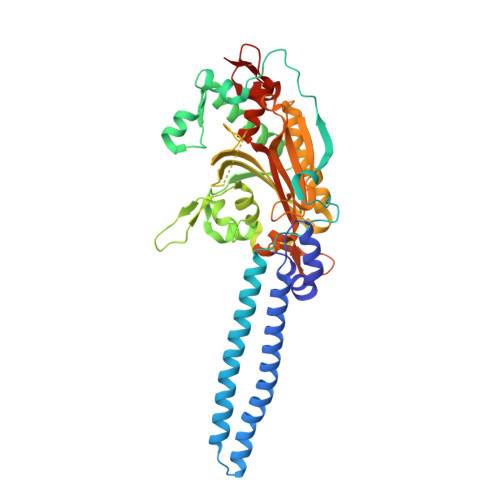Structural Insights into the Binding of Natural Pyrimidine-Based Inhibitors of Class II Aminoacyl-tRNA Synthetases.
Pang, L., Nautiyal, M., De Graef, S., Gadakh, B., Zorzini, V., Economou, A., Strelkov, S.V., Van Aerschot, A., Weeks, S.D.(2020) ACS Chem Biol 15: 407-415
- PubMed: 31869198
- DOI: https://doi.org/10.1021/acschembio.9b00887
- Primary Citation of Related Structures:
6HDZ, 6HE1, 6HE3, 6HHV, 6HHW, 6HHX, 6HHY, 6HHZ, 6HI0, 6RLT, 6RLU, 6RLV, 6S30, 6SJC - PubMed Abstract:
The pyrimidine-containing Trojan horse antibiotics albomycin and a recently discovered cytidine-containing microcin C analog target the class II seryl- and aspartyl-tRNA synthetases (serRS and aspRS), respectively. The active components of these compounds are competitive inhibitors that mimic the aminoacyl-adenylate intermediate. How they effectively substitute for the interactions mediated by the canonical purine group is unknown. Employing nonhydrolyzable aminoacyl-sulfamoyl nucleosides substituting the base with cytosine, uracil, and N3-methyluracil the structure-activity relationship of the natural compounds was evaluated. In vitro using E. coli serRS and aspRS, the best compounds demonstrated IC 50 values in the low nanomolar range, with a clear preference for cytosine or N3-methyluracil over uracil. X-ray crystallographic structures of K. pneumoniae serRS and T. thermophilus aspRS in complex with the compounds showed the contribution of structured waters and residues in the conserved motif-2 loop in defining base preference. Utilizing the N3-methyluracil bound serRS structure, MD simulations of the fully modified albomycin base were performed to identify the interacting network that drives stable association. This analysis pointed to key interactions with a methionine in the motif-2 loop. Interestingly, this residue is mutated to a glycine in a second serRS (serRS2) found in albomycin-producing actinobacteria possessing self-immunity to this antibiotic. A comparative study demonstrated that serRS2 is poorly inhibited by the pyrimidine-containing intermediate analogs, and an equivalent mutation in E. coli serRS significantly decreased the affinity of the cytosine congener. These findings highlight the crucial role of dynamics and solvation of the motif-2 loop in modulating the binding of the natural antibiotics.
Organizational Affiliation:
Biocrystallography, Department of Pharmaceutical and Pharmacological Sciences , KU Leuven , Herestraat 49 Box 822 , B-3000 Leuven , Belgium.

















